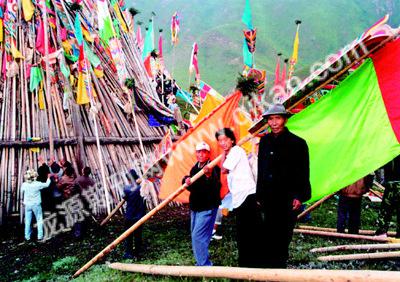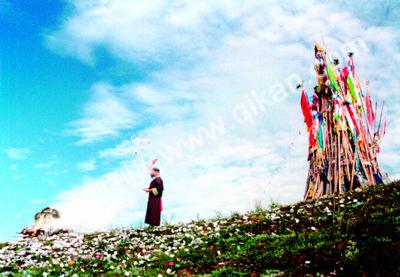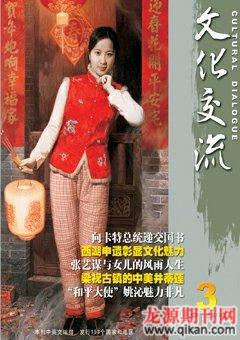Arrow Festival in Qinghai
Lin Qing

Gannan, an autonomous Tibetan prefecture on the edge of Qinghai-Tibet Plateau in Qinghai Province, displays quite a few unique regional characteristics and lifestyles. Geographically, undulating grasslands spread against snow-capped mountains; the Yellow River turns there sharply and majestically for the first time after its headwater. Religiously, it is home to the Labrang Monastery, a very important sanctuary of the Gelug school of Tibetan Buddhism. Culturally, the Tibetan people there celebrate a variety of ancient customs. The arrow festival, one of the most important occasions for Tibetan people in this part of China, dates back to more than 1,000 years.
The arrow festival celebrates mountain gods and usually lasts from May to June every year. Arrows play an important part in Tibetan history. In ancient times when tribes in the wilderness fought each other, warriors traveled and marked their way with arrows so that they would find their way back home. The burial grounds of dead soldiers were marked with arrows so that tomb visits would be possible. Another legend has it that once upon a time the area was haunted by a monster while tribes had difficulty having baby boys. To solve the problem, the living Buddha at Labrang Monastery sent a magic arrow to the snow mountain. The mountain god was so pleased with the gift that he annihilated the monster. Peace and prosperity came back to tribes and boys got born. Moreover, King Gesar, the legendary hero of Tibet, is said to have used arrows to drive away monsters. It is only natural that local Tibetans hold an arrow festival every year in worship of mountain gods.
Scholars confirm that mountain gods as most ancient and most powerful totems play an important part in Tibetan ideology and mythology, for snow-capped mountains nurture meadows, the lifeline of Tibetan people.

In Gannan, an arrow platform is usually erected on a mountain top or on a slope where the mountain god is believed to be residing. The site is usually chosen and built under the guidance and supervision of a lama from Nyingma school of Tibetan Buddhism. Before the platform is erected, a treasure case must be buried there. Typically the case contains sutras, Buddha statues, sacrificial utensils, medicinal herbs, gold and silver, gemstones and pearls. It is wrapped up tightly with a piece of yellow silk or brocade. Moreover, the pit must be paved and lined with treasure bottles containing gold, silver, grain before the treasure case be placed in. The treasure box is covered with wool and cypress branches, and sprinkled with sheep milk. Then the pit is ready and an arrow post called “Life Timber”, made of a cypress tree carved to have four square corners, is erected in the center of the platform. The Life Timber would serve as the pillar of the arrow piles.
The man charged with the task of finding and felling the cypress timber must be one who has not touched a corpse in the past year and he must go through a slew of rituals before setting out to fell a tree and make the life timber.
A ritual must be held to set up the Life Timber and the tribe or village arrow. The presiding monk begins by praying. Three men, armed respectively with an arrow, a dagger and an arch, patrol the site while the male population looks on. After the ritual, the pit is filled and the huge arrow that represents a village or a tribe is erected. After the platform is built and village or tribe arrow is erected, family representatives offer their own arrows. Traditionally women are forbidden to take part in the procedure. But in some areas women are allowed to attend if a family has no adult males or males are away from home, but women are not allowed to stick family arrows on the post.
Preparations for the arrow festival start more than fifteen days before the festival. The arrow shall be made, feathers shall be prepared, sutra banners and paper horses shall be made and printed. The arrow for the mountain god, made of a complete tree, is usually 10 meters long. The arrow feathers are made of three timber boards, painted with images such as the sun, the moon, animals, and symbols. The arrow shaft is decorated with silk banners in red, yellow, blue, green and white, representing respectively the sun, the land, the sky, the forest and the cloud. Two clusters of white sheep wool hang at the end of the arrow boards. Each family must make its own magic arrow. The ambrosia, a mixture of barley flour, butter, fresh milk, wine, and sweets, is also prepared before the festival. Paper horses, printed with mythical images such as flying horses and dragons, must also be prepared.
All the preparations must be completed one day before the festival. As in some regions an arrow site is far away from habitats, things must be carried by horses to the foot of a mountain a day ago so that they can be used at the festival.
Usually people get up early in darkness and then travel to the site carrying all long arrows, cypress branches and ambrosia.
A platform measures a few dozen meters in height and in diameter. The arrows in the top center form a giant triangle. The priest begins to pray before sunrise. The first thing to do is to set fire on cypress branches and throw the ambrosia into the fire. Water and wine are sprinkled upon the ambrosia, causing palls of smoke to soar and spiral. Trumpets are blown and people burst into chanting. Paper horses in red and green are thrown into sky in the direction of east and people step clockwise around the ambrosia pile upholding family arrows. It is a swirl of movements and colors in the early morning sunshine.
Then adult male representatives from families are ready to thrust family arrows onto the post. The villages arrow must be thrust in before families flock to plunge their arrows on to the post. While arrows are being stuck into the post, other people gallop on horses around the site and guns are fired. The post with hundreds of new arrows looks majestic and formidable in the morning sun.
After arrows are thrust onto the post, people rush to a nearby site to hang sutra banners. The banner post and the arrow post are linked with a three-thread wool rope, suggesting the communications between gods, heaven and humans. After a ceremony, people begin to walk around the banner post and cite sutras. The arrow ceremony takes about two to three hours. In some areas a horse race is held after the ceremony. Many people stay back to pray at the arrow site or banner site. Some people bury additional treasure boxes there.
It is strongly believed locally that highly respected people among them and those who contribute to the survival and prosperity of a tribe will become mountain gods after they pass away from this world. □

